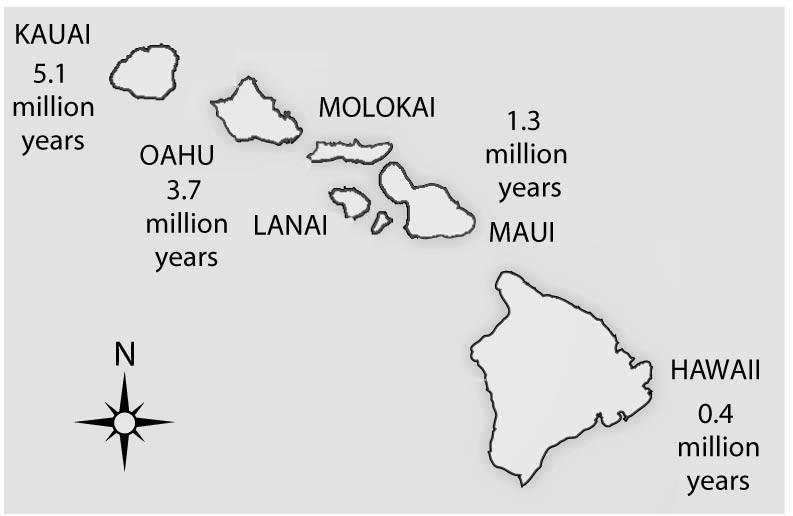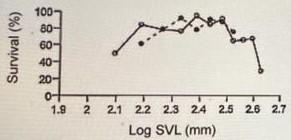1) Which statement about variation is true?
A) All phenotypic variation is the result of genotypic variation.
B) All genetic variation produces phenotypic variation.
C) All nucleotide variability results in neutral variation.
D) All new alleles are the result of nucleotide variability.
D) All new alleles are the result of nucleotide variability.
2) Genetic variation ___.
A) is created by the direct action of natural selection
B) arises in response to changes in the environment
C) must be represent in a population before natural selection can act upon the population
D) tends to be reduced by which diploid organisms produce gametes
C) must be represent in a population before natural selection can act upon the population
A large population of laboratory animals has been allowed to breed randomly for a number of generations. After several generations, 25% of the animals display a recessive trait (aa), the same percentage as at the beginning of the breeding program. The rest of the animals show the dominant phenotype, with heterozygotes indistinguishable from the homozygous dominants.
3) What is the most reasonable conclusion that can be drawn from
the fact that the frequency of the recessive trait (aa) has not
changed over time?
A) The two phenotypes are about equally
adaptive under laboratory conditions.
B) The genotype AA is lethal.
C) There has been a high rate of mutation of allele A to allele a.
D) There has been sexual selection favoring allele a.
A) The two phenotypes are about equally adaptive under laboratory conditions.

4) Soon after the island of Hawaii rose above the sea surface (somewhat less than one million years ago), the evolution of life on this new island should have been most strongly influenced by ___.
A) a genetic bottleneck
B) sexual selection
C) habitat differentiation
D) the founder effect
D) the founder effect
5) The Dunkers are a religious group that moved from Germany to Pennsylvania in the mid-1700s. They do not marry with members outside their own immediate community. Today, the Dunks are genetically unique and differ in gene frequencies, at many loci, from all other populations including those in their original homeland. Which of the following likely explains the genetic uniqueness of this population?
A) population bottleneck and Hardy-Weinberg equilibrium
B) heterozygote advantage and stabilizing selection
C) mutation and natural selection
D) founder effect and genetic drift
D) founder effect and genetic drift
6) An earthquake decimates a ground-squirrel population, killing 98% of the squirrels. The surviving population happens to have broader stripes, on average, than the initial population. If broadness of stripes is genetically determined, what effect has the ground-squirrel population experienced during the earthquake?
A) directional selection
B) disruptive selection
C) a founder event
D) a genetic bottleneck
D) a genetic bottleneck
7) Which of the following is the predictable outcome of increase between two populations?
A) lower average fitness in both populations
B) higher average fitness in both populations
C) increased genetic difference between the two populations
D) decreased genetic difference between the two populations
D) decreased genetic difference between the two populations

8) Examine the figure above. What type of selection for body size appears to be occurring in these marine iguanas?
A) directional selection
B) stabilizing selection
C) disruptive selection
D) You cannot determine the type of selection from the above information
B) stabilizing selection
9) Currently, the only predators of Galápagos marine iguanas are
Galápagos hawks. Iguana body size is not correlated with risk of hawk
predation, although small iguanas can sprint faster than large
iguanas. If predators (for example, cats) that preferentially catch
and eat slower iguanas are introduced to the island, iguana body size
is likely to ________ in the absence of other factors; the iguanas
would then be under ________ selection.
A) increase;
directional
B) increase; disruptive
C) decrease;
directional
D) decrease; disruptive
C) decrease; directional
10) A biologist doing a long-term study on a wild spider population observes increased variation in silk thickness. Which of the following could the spider population be experiencing?
A) directional selection
B) stabilizing selection
C) disruptive selection
D) genetic drift
C) disruptive selection
11) Most Swiss starlings produce four to five eggs in each clutch.
Starlings producing fewer or more than this have reduced fitness.
Which of the following terms best describes this situation?
A)
directional selection
B) stabilizing selection
C) disruptive selection
D) sexual selection
B) stabilizing selection
12) A proficient engineer can easily design skeletal structures that
are more functional than those currently found in the forelimbs of
such diverse mammals as horses, whales, and bats. The actual forelimbs
of these mammals do not seem to be optimally arranged because
A)
natural selection has not had sufficient time to create the optimal
design in each case, but will do so given enough time.
B) in many
cases, phenotype is not merely determined by genotype, but by the
environment as well.
C) though we may not consider the fit
between the current skeletal arrangements and their functions
excellent, we should not doubt that natural selection ultimately
produces the best design.
D) natural selection is generally
limited to modifying structures that were present in previous
generations and in previous species.
D) natural selection is generally limited to modifying structures that were present in previous generations and in previous species.
In those parts of equatorial Africa where the malaria parasite is most common, the sickle-cell allele constitutes 20% of the B hemoglobin alleles in the human gene pool.
13) In the United States, the parasite the causes malaria is not present, but African-Americans whose ancestors were from equatorial Africa are present. What should be happening to the sickle-cell allele in the United States, and what should be happening to it in equatorial Africa?
A) stabilizing selection; disruptive selection
B) disruptive selection; stabilizing selection
C) directional selection; disruptive selection
D) directional selection; stabilizing selection
D) directional selection; stabilizing selection
Two populations of birds with somewhat different coloration live on opposite sides of a peninsula. The habitat between the populations is not suitable for these birds. When birds from the two populations are brought together, they produce young whose appearance is intermediate between the two parents. These offspring will breed with each other or with birds from either parent population, and all offspring of these pairings appear intermediate to various degrees.
14) Three populations of crickets look very similar, but the males have courtship songs that sound different. What function would this difference in song likely serve if the populations came in contact?
A) temporal reproductive isolating mechanism
B) a postzygotic reproductive mechanism
C) a behavioral reproductive isolation mechanism
D) a gametic reproductive isolating mechanism
C) a behavioral reproductive isolation mechanism
15) The peppered moth provides a well-known example of natural selection. The light-colored form of the moth was predominant in England before the industrial revolution. In the mid-nineteenth century, a dark-colored form appeared. The difference is produced by a dominant allele of one gene. By about 1900, approximately 90% of the moths around industrial areas were dark colored, whereas light-colored moths were still abundant elsewhere. Apparently, birds could readily find the light moths against the soot-darkened background in industrial areas and therefore were eating more light moths. Recently, use of cleaner fuels has greatly reduced soot in the landscape, and the dark-colored moths have been disappearing. Should the two forms of moths be considered separate species?
A) Yes, because natural selection has affected the frequency of the two different forms.
B) Yes, because they completely different coloration.
C) Yes, because they are reproductively isolated based on habitat.
D) No.
D) No.
16) Two species of frogs belonging to the same genus occasionally mate, but the embryos stop developing after a day and then die. These two frog species separate by ___.
A) reduced hybrid viability
B) hybrid breakdown
C) reduced hybrid fertility
D) gametic isolation
A) reduced hybrid viability

17) Why should deepwater shrimp on different sides of the isthmus have diverged from each other earlier than shallow-water shrimp?
A) They have been geographically isolated from each other for a longer time.
B) Cold temperatures, associated with deep water, have accelerated the mutation rate, resulting in faster divergence in deepwater shrimp.
C) The rise of the land bridge was accompanied by much volcanic activity. Volcanic ash contains heavy metals, which are known mutagens. Ash fall caused high levels of heavy metals in the ocean sediments underlying the deep water, resulting in accelerated mutation rates and faster divergence in deepwater shrimp.
D) Fresh water entering the ocean from the canal is both less dense and cloudier than seawater. The cloudy fresh water interferes with the ability of shallow-water shrimp to locate mating partners, which reduces the frequency of mating, thereby slowing the introduction of genetic variation.
A) They have been geographically isolated from each other for a longer time.

18) In which habitat should one find snapping shrimp most closely
related to shrimp that live in habitat A4?
A) A3
B)
A5
C) B4
D) either A3 or A5
C) B4

19) Which of these habitats is likely to harbor the most recently diverged species?
A) A5
B) B4
C) A3
D) A1
D) A1

20) Which habitats should harbor snapping shrimp species with the
greatest degree of genetic divergence from each other?
A) A1 and A5
B) A1 and B5
C) A5 and B5
D) Both A1/A5 and B1/B5 should have the greatest,
but equal amounts of, genetic divergence.
C) A5 and B5

21) The Panama Canal was completed in 1914, and its depth is about 50
feet. After 1914, snapping shrimp species from which habitats should
be most likely to form hybrids as the result of the canal?
A) A5
and B5
B) A3 and B3
C) A1 and B1
D) A1—A3 and B1—B3 have equal likelihoods of
harboring snapping shrimp species that can hybridize.
C) A1 and B1
22) A small number of birds arrive on an island from a neighboring larger island. This small population begins to adapt to the new food plants available on the island, and their beaks begin to change. About twice a year, one or two more birds from the neighboring island arrive. These new arrivals ___.
A) speed up the process of speciation
B) tend to promote adaptation to the new food plants
C) tend to retard adaptation to the new food plants
D) represent a colonizing event
C) tend to retard adaptation to the new food plants
23) According to the concept of punctuated equilibrium, the "sudden: appearance of a new species in the fossil record means that ___.
A) the species is now extinct
B) speciation occurred in one generation
C) speciation occurred rapidly in geologic time
D) the species will consequently have a relatively short existence, compared with other species
C) speciation occurred rapidly in geologic time